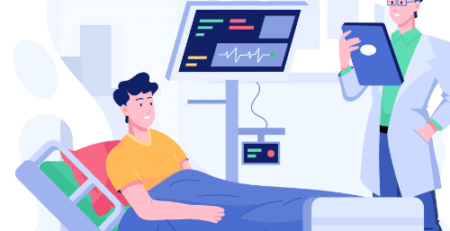Personalized medicine is slowly replacing one-size-fits-all medication. It is more precise, effective, and focused on the patient. Personalized medicine, also called precision medicine, is changing the way diseases are diagnosed, treated, and avoided. This is thanks to advances in genetics, data analytics, and biotechnology.
Healthcare doctors may now create personalized treatment programs that work better, have fewer side effects, and make patients more likely to stick to their plans by taking into account a person’s unique genetic makeup, lifestyle, and environment. Personalization isn’t simply a trend in medicine; it’s the basis for new ideas in healthcare that are happening right now.
What is personalized medicine?
Personalized medicine means tailoring medical care to a person’s genes, medical history, and way of life. This method doesn’t use the same treatment plans for everyone. Instead, it customizes therapy to focus on the biological processes that are unique to each patient.
This concept is especially useful in fields like oncology, rare diseases, and chronic illnesses, where genetic abnormalities have a big effect on how diseases evolve and how well treatments work. By looking at a patient’s DNA, doctors may guess which therapies are most likely to work or which ones might trigger bad reactions. This makes care more effective and safer.
Breakthroughs That Are Driving the Change
The expansion of customized medicine is being driven by a number of scientific and technological advances. The most important thing is that genome sequencing costs less. It took more than ten years and billions of dollars to finish the Human Genome Project. You may now get a full genome sequence for a few hundred bucks, and in just a few days.
AI (artificial intelligence) and machine learning are other important tools. These technologies can look at huge amounts of data, such as DNA sequences and real-time health monitoring, to find patterns and guess how patients will react. Biomarker discovery is also highly important for figuring out which patients should get which targeted medicines, notably for cancer treatment.
Another big change is the advent of companion diagnostics, which are tests that show whether a certain drug is right for a patient. This mix of diagnostic technologies and drugs is making pharmacological therapy far more successful.
How Personalized Medicine Works in the Real World
Oncology is where tailored therapy has had the most obvious success. Trastuzumab is a medicine that works well on people who have the HER2 protein. For example, people with HER2-positive breast cancer are now routinely given this therapy. Drugs like pembrolizumab (Keytruda) are also given based on genetic markers, such as the level of PD-L1 expression or the status of microsatellite instability (MSI). In pharmacogenomics, customized medicine involves helping to figure out how much of a drug a person can handle based on how well they can break it down. For example, differences in the CYP2C19 gene change how people react to clopidogrel, a major blood thinner. Changing treatment based on this information lowers the chance of getting side effects or not getting better.
Preventive measures are also being changed, in addition to treatment. People who are genetically prone to diseases like BRCA-related breast cancer or Lynch syndrome can take efforts to lower their risk, such as getting more screenings or having preventive operations.
There are a lot of problems that need to be solved before personalized medicine can become widely used, even if it has a lot of potential. The biggest problem is figuring out how to use genetic information in everyday medical care. Most healthcare systems still don’t have the right tools or qualified staff to understand and use complicated genetic data.
Concerns about data privacy and ethics are also quite important. Genomic data is very private and might affect family members, so strong data protection systems are quite important. There is also the problem of healthcare equity. Right now, tailored treatment may only be available to patients in well-funded institutions or wealthy countries, which raises concerns about expanding healthcare gaps. Cost and reimbursement are still big problems. The cost of genome sequencing has gone down, but the testing, analytics, and personalized treatments that go along with it are still expensive. Many insurance companies are still hesitant to pay for tailored treatments, especially when the long-term advantages aren’t completely known yet.
Challenges on the Road to Personalization
CMI Analysis: Trends in the Market and the Competition:
CMI says that the worldwide personalized medicine market would be worth more than $110 billion by 2030, with a compound annual growth rate (CAGR) of more than 10%. The CMI research shows that there is strong momentum since there is a growing need for focused therapeutics, early diagnoses, and precise medication development.
Genomics companies, pharmaceutical companies, diagnostics providers, and digital health startups all work together in the vendor ecosystem. Illumina, Roche, Thermo Fisher Scientific, and 23andMe are some of the companies that are pushing the envelope in genome sequencing, molecular diagnostics, and genetic testing that is available directly to consumers.
CMI research reveals that being able to work with other systems, analyze data in real time, and use AI are becoming more important for businesses to stay ahead of the competition. More and more healthcare professionals are using platforms from vendors that can easily combine genetic findings with clinical workflows. Also, strategic alliances between pharmaceutical and technology businesses are speeding up the pace of innovation. Drug makers are working with data analytics companies to make finding biomarkers easier and speed up the process of making new drugs. CMI also says that there is an increasing interest in multi-omics systems, which combine genomes, proteomics, and metabolomics to provide us even deeper, more complete pictures of a patient’s health. These platforms are going to change what it really means to personalize healthcare.
The Future: Healthcare Ecosystems That Are Unique to You
The growth of personalized healthcare ecosystems is intimately linked to the future of personalized medicine. These ecosystems will bring together wearable gadgets, home testing kits, and AI tools into a single platform that supports preventive, diagnostic, and therapeutic care. What if your smartwatch told your doctor about irregular heart rhythms? Then, using your genomic data, the doctor could figure out your risk profile and give you a personalized prescription schedule that would be sent straight to your home. This is what fully integrated, tailored treatment can do.
Precision public health, which combines genomic and behavioral data to anticipate and stop disease in large groups of people, is also becoming more popular. Governments and health groups are looking into how to use genetic data from everyone to make screening programs and vaccination plans better.
Last Thoughts: Personalized Medicine
Personalized medicine is a big change from reactive to proactive, from general to specific, and from broken to connected care. There are still problems to solve, but there is little doubt that personalized medicine is gaining ground.
According to CMI analysis, companies that put money into solutions that can grow, work with other systems, and are morally sound will be at the top of their game in this new era. For patients, this implies medicines that are safer and more effective and that are made particularly for them. For providers, it implies greater results and less money spent. It means that the healthcare system can keep going by being precise. Personalized medicine isn’t just about treating sickness; it’s also about getting to know the person, figuring out their risk, and helping them stay healthy for life. Personalized medicine is the future of healthcare, and it’s already here.
Connect with our Experts


